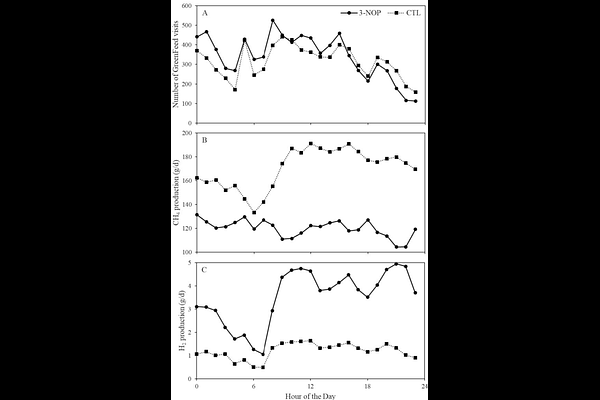Effects of 3-Nitrooxypropanol on Methane Emission, Growth and Feed Intake in Growing Calves from 5 Months of Age

Effects of 3-Nitrooxypropanol on Methane Emission, Growth and Feed Intake in Growing Calves from 5 Months of Age
Burgers, E. E. A.; Bannink, A.; Walker, N.; Zihlmann, R.; van Gastelen, S.
AbstractThis study aimed to test the effect of 3-nitrooxypropanol (3-NOP) on methane (CH4) emission, feed intake, and body weight (BW) of calves from 5 mo of age. Seventy calves were enrolled in the acclimatization period (3 wk), after which 60 calves were selected based on their ability to use the automated feed bins (FB) and the GreenFeed system. These 60 calves were blocked in pairs for sex, breed, and BW, and within block randomly assigned to 1 of 2 dietary treatments: a partially mixed ration (PMR) supplemented with (1) a placebo contrate (CTL), or with (2) a 3-NOP concentrate (on average 121 mg 3-NOP/kg dry matter of total ration). The acclimatization period was followed by a covariate period (2 wk) in which baseline measurements were performed, and afterwards the treatment period (12 wk) started where the calves received 1 of the 2 dietary treatments. Next to PMR, the calves received up to 1280 g/ day bait in the GreenFeed system, which was used for emission measurements. For analyses, all data was averaged for the covariate period and for different periods in the treatment wk: 1-3, 4-6, 7-9 and 10-12. Upon 3-NOP supplementation, CH4 production (g/d) was significantly reduced by 31.3% in wk 1 to 3, by 27.1% in wk 4 to 6, by 30.0% in wk 7 to 9, and by 30.7% in wk 10 to 12 compared to CTL, and CH4 intensity (g/kg BW) was significantly reduced by 30.0% in week 1 to 3, by 25.8% in wk 4 to 6, by 27.9% in wk 7 to 9, and by 28.6% in wk 10 to 12 compared to CTL. Overall, 3-NOP calves had a reduction of 29.8% for CH4 production, 19.4% for CH4 yield (g/kg dry matter intake; DMI), and 27.9% for CH4 intensity. Calves receiving 3-NOP had a lower total DMI (6.1 kg/d) compared to CTL (6.9 kg/d), driven by a lower DMI of PMR. In every period, calves in 3-NOP had a lower BW (overall: 251 kg) compared to CTL (overall: 258 kg). The 3-NOP group and the CTL group did not differ in initial BW, but calves in the 3-NOP group had a lower final BW (290 kg) compared to CTL (301 kg). Both feed to gain ratio and feed efficiency did not differ between the two treatment groups. It can be concluded that 3-NOP is a promising strategy to persistently decrease CH4 emission in growing beef calves from 5 to 8 mo of age, without negatively impacting feed efficiency.